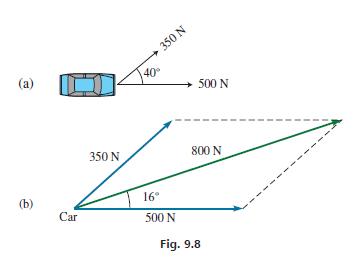Find the resultant vectors if the given changes are made in the indicated examples of this section.
Question:
Find the resultant vectors if the given changes are made in the indicated examples of this section.
In Example 6, if 20° replaces 40°, what is the resultant force?
Data from Example 6
Two persons pull horizontally on ropes attached to a car that is stuck in mud. One person pulls with a force of 500 N directly to the right, while the other person pulls with a force of 350 N at an angle of 40° from the first force, as shown in Fig. 9.8(a). Find the resultant force on the car.
We make a scale drawing of the forces as shown in Fig. 9.8(b), measuring the magnitudes of the forces with a ruler and the angles with a protractor. [The scale drawing of the forces is made larger and with a different scale than that in Fig. 9.8(a) in order to get better accuracy.] We then complete the parallelogram and draw in the diagonal that represents the resultant force. Finally, we find that the resultant force is about 800 N and that it acts at an angle of about 16° from the first force.

Step by Step Answer:

Basic Technical Mathematics
ISBN: 9780137529896
12th Edition
Authors: Allyn J. Washington, Richard Evans





